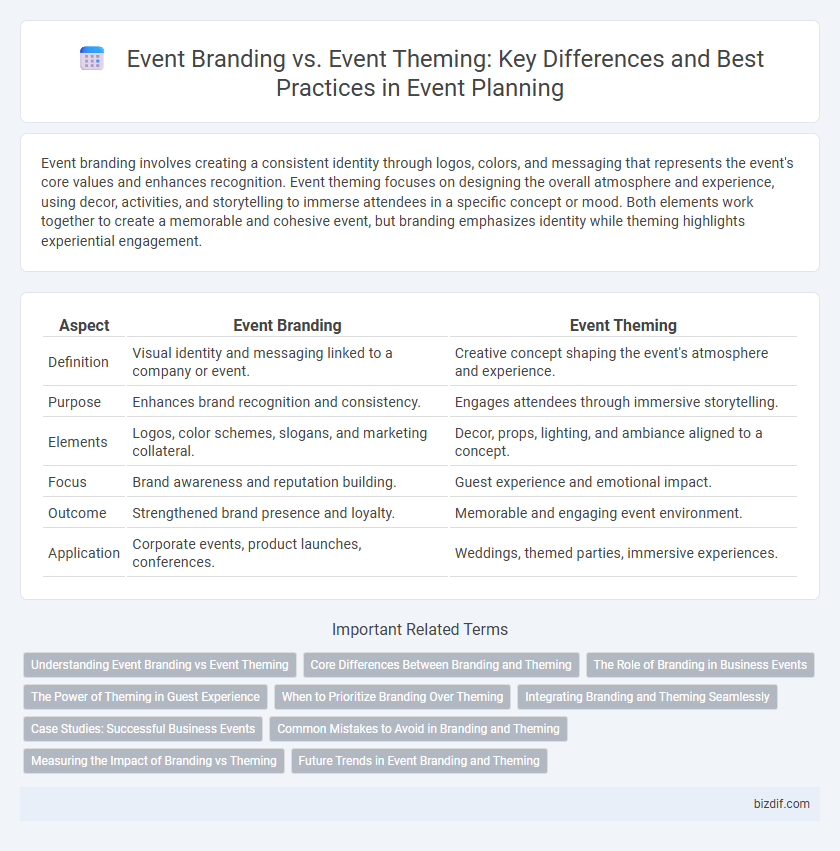Event branding involves creating a consistent identity through logos, colors, and messaging that represents the event's core values and enhances recognition. Event theming focuses on designing the overall atmosphere and experience, using decor, activities, and storytelling to immerse attendees in a specific concept or mood. Both elements work together to create a memorable and cohesive event, but branding emphasizes identity while theming highlights experiential engagement.
Table of Comparison
| Aspect | Event Branding | Event Theming |
|---|---|---|
| Definition | Visual identity and messaging linked to a company or event. | Creative concept shaping the event's atmosphere and experience. |
| Purpose | Enhances brand recognition and consistency. | Engages attendees through immersive storytelling. |
| Elements | Logos, color schemes, slogans, and marketing collateral. | Decor, props, lighting, and ambiance aligned to a concept. |
| Focus | Brand awareness and reputation building. | Guest experience and emotional impact. |
| Outcome | Strengthened brand presence and loyalty. | Memorable and engaging event environment. |
| Application | Corporate events, product launches, conferences. | Weddings, themed parties, immersive experiences. |
Understanding Event Branding vs Event Theming
Event branding centers on creating a cohesive identity through logos, color schemes, and messaging that reflect the event's purpose and appeal to the target audience. Event theming focuses on designing the event environment, including decorations, activities, and overall atmosphere, to immerse attendees in a specific concept or experience. Understanding the distinction ensures strategic alignment of visual elements and experiential components, enhancing attendee engagement and event impact.
Core Differences Between Branding and Theming
Event branding focuses on creating a consistent identity through logos, color schemes, and messaging to reinforce the host's image and values. Event theming centers on the overall atmosphere and experience, utilizing decor, activities, and style to immerse attendees in a specific concept or story. While branding builds recognition and loyalty, theming enhances engagement and emotional connection during the event.
The Role of Branding in Business Events
Event branding establishes a cohesive identity through logos, colors, and messaging that reinforces a company's values and leaves a lasting impression on attendees. It differentiates the business in a competitive market, enhancing recognition and trust, which boosts attendee engagement and loyalty. Effective event branding drives consistent communication, making business events memorable and aligned with overall marketing strategies.
The Power of Theming in Guest Experience
Event theming transforms guest experience by creating an immersive atmosphere that resonates emotionally, enhancing memory retention and engagement. Unlike event branding, which focuses on visual identity and messaging consistency, theming integrates decor, activities, and ambiance to evoke specific feelings and stories. This holistic approach not only captivates attendees but also fosters deeper connections, making the event more memorable and impactful.
When to Prioritize Branding Over Theming
Prioritize event branding over theming when the primary goal is to enhance brand recognition, reinforce corporate identity, or communicate a specific brand message to attendees. Branding is crucial for corporate events, product launches, and conferences where consistent visual elements like logos, color schemes, and slogans build trust and loyalty. Theming becomes secondary when the emphasis is on long-term brand impact rather than temporary ambiance or entertainment.
Integrating Branding and Theming Seamlessly
Integrating event branding and theming seamlessly enhances audience engagement by creating a coherent visual and experiential identity. Consistent use of logos, color schemes, and messaging in both physical decor and digital assets ensures the event's purpose and brand values resonate clearly. Strategic alignment of thematic elements with brand guidelines elevates the event's impact and fosters a memorable attendee experience.
Case Studies: Successful Business Events
Case studies reveal that event branding focuses on reinforcing the company's identity through logos, color schemes, and messaging, creating a consistent visual impact across all event materials. Event theming immerses attendees in a specific atmosphere or story, enhancing engagement by aligning decoration, activities, and content with a unified concept. Successful business events, such as Salesforce's Dreamforce and Apple's product launches, effectively integrate both branding and theming to create memorable experiences that strengthen customer loyalty and brand recognition.
Common Mistakes to Avoid in Branding and Theming
Confusing event branding with event theming often leads to inconsistent messaging and diluted audience impact. Avoid overloading themes with complex branding elements, which can distract from the core event experience. Prioritize clear, cohesive visuals and messaging that align closely with the event's purpose to ensure both branding and theming enhance attendee engagement effectively.
Measuring the Impact of Branding vs Theming
Measuring the impact of event branding centers on tracking brand recognition, audience recall, and engagement metrics such as social media mentions and brand sentiment analysis. In contrast, event theming effectiveness is assessed through attendee experience surveys, emotional resonance, and the coherence between event activities and the theme narrative. Combining data from branded touchpoints and theme-driven interactions provides a comprehensive understanding of overall event success and Return on Investment (ROI).
Future Trends in Event Branding and Theming
Future trends in event branding emphasize immersive digital experiences and personalized content driven by AI to enhance audience engagement. Event theming is evolving with augmented reality integration, creating interactive environments that support brand storytelling and foster emotional connections. Sustainable and inclusive design elements are increasingly prioritized, reflecting growing social awareness in event production.
Event branding vs Event theming Infographic

 bizdif.com
bizdif.com